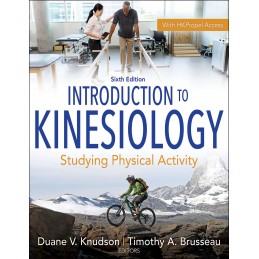This is the loose-leaf version of
Introduction to Kinesiology, Sixth Edition With HKPropel Access, which offers students a less expensive, printed version of the text.
Introduction to Kinesiology:: Studying Physical Activity, Sixth Edition With HKPropel Access, offers students a comprehensive overview of the field of kinesiology and explores the subdisciplinary fields of study, common career paths, and emerging ideas that are part of this dynamic and expanding discipline. This engaging, full-color introductory text stimulates curiosity about the vast field of kinesiology and generates awareness of the long-standing and current issues that kinesiology professionals seek to understand and solve.
Introduction to Kinesiology, Sixth Edition, features a three-section structure that has always been a strength of this leading introductory textbook. Part I examines the diversity of physical activity and kinesiology and summarizes the importance of knowledge gained through physical activity experiences. Part II delves into the seven major subdisciplines of kinesiology, with an overview of major historical events, research methods, professional work and application, and ideas for career advancement in each. Part III elaborates on professionalism and then examines five main areas for career opportunities.
With hundreds of updated references, the sixth edition includes the latest research and data available as well as an increased emphasis on sensitivity and inclusion. New editor Timothy A. Brusseau, a national youth physical activity expert who has served on the board of directors for the American Kinesiology Association, contributes his expertise and insight to the text. Additional updates to the sixth edition include the following::
- Related online learning tools delivered through HKPropel offer interactive opportunities to engage with and better understand the content.
- Updates to data, research, and graphics incorporate the most recent discoveries.
- New Research and Evidence-Based Practice in Kinesiology sidebars highlight influential contemporary studies and discuss how they can be applied in professional settings as an evidence-based practice.
- New Subdisciplinary Highlight sidebars feature trending topics in the subdisciplines of kinesiology.
- New Hot Career Opportunity sidebars discuss emerging career paths for kinesiology and exercise science majors.
The online learning activities include audio, video, drag-and-drop activities, and scenario-based exercises to fully immerse students into the various aspects of kinesiology. Students will learn how to read and evaluate research and will develop the ability to think critically in order to confront specific challenges. Most of the activities can be assigned, and progress tracked, directly through HK
Propel. Chapter quizzes (assessments), which are automatically graded, may also be assigned to test comprehension of critical concepts.
Ample learning aids within the text—such as chapter objectives, summaries, key points, and review questions—will also aid in knowledge retention. Opening scenarios at the beginning of each chapter feature a specific athlete, activity, or issue in kinesiology that serves to illustrate the main points.
Introduction to Kinesiology provides essential information for students embarking on their study of kinesiology, and this updated sixth edition prepares them for future courses and further study.
Note:: A code for accessing HK
Propel is included with all new print books.


 Dostawa
Dostawa
 Płatność
Płatność
 Zwroty
Zwroty
